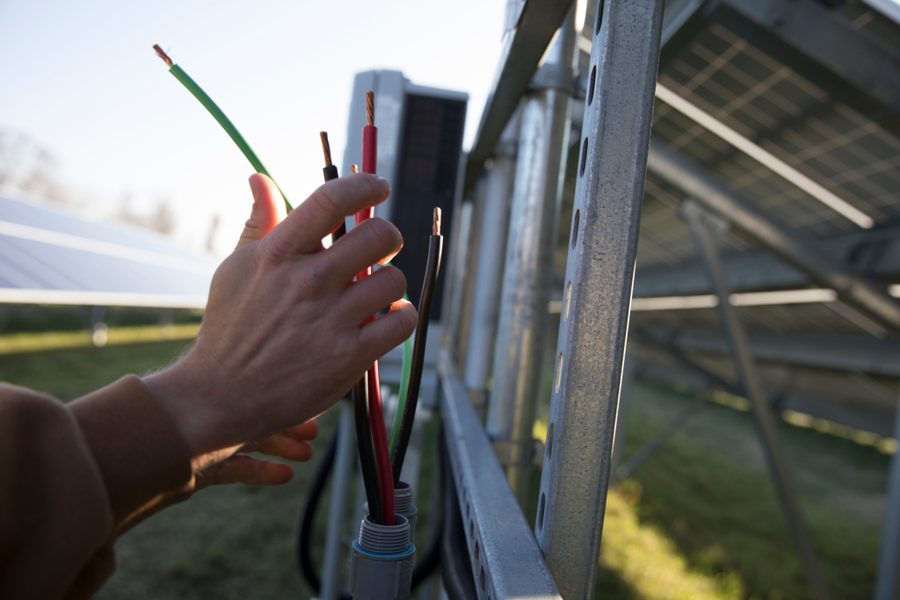
In recent weeks, talk of a federal job guarantee has swept into the national political debate. Possible 2020 presidential hopefuls Sens. Kristen Gillibrand (D-N.Y.) and Cory Booker (D-N.J.) have both expressed their support for the idea, and Booker recently introduced legislation to create a job guarantee pilot program. And after Sen. Bernie Sanders (I-Vt.) announced his team was compiling a job guarantee proposal, opinions abounded from the left, right and center.
The National Review calls a job guarantee a socialist plot liable to bankrupt the country. Kevin Drum at Mother Jones adopted a similar line, chiding the idea of a job guarantee as “insane” and liable to “cost a fortune.” Denouncing the program as “workfare”, comparable to Victorian poorhouses, left-wing writer Matt Bruenig asks — fairly — “what are these jobs actually going to be like? What does actually fit all the constraints of workfare?
“Despite claims to the contrary, you will not be building bridges out of a job guarantee office,” Bruenig writes, “You will not be doing child care out of a job guarantee office… All of these tasks require either high levels of skill, large amounts of capital, or permanence of service, none of which meet the constraints that a workfare program has to deal with.”
I’ll let the proposals—one from the Levy Economics Institute and another commissioned by the Center for Budget and Policy Priorities — speak for themselves on this front, and I recently spoke with authors of each for The Intercept if you want a longer look at the details. In brief, neither of these proposals urge cuts to existing safety net benefits, nor do they make getting things like SNAP assistance (“food stamps”) dependent on whether someone is employed in a job guarantee project.
Levy economist Pavlina Tcherneva, a longtime researcher and proponent of the job guarantee, has also published an extensive Q & A addressing several commonly asked questions, as well as a working paper that gets into the weeds of its design and implementation. (For what it’s worth, the largely simpatico Levy and CBPP papers adopt slightly different positions on the question of what kinds of jobs would be created.)
But Breunig’s complaint elides with a broader one voiced by the Right — that the kinds of jobs a job guarantee would create are essentially useless activities, and there simply aren’t enough “shovel-ready” projects to funnel people into meaningful work. Libertarian writer Meghan McArdle, for instance, argues in the Washington Post that the government “doesn’t much use many of the skills that low-wage workers have, such as bartending or short-order cooking. And it doesn’t have much presence in areas that employ a lot of low-skilled, undifferentiated labor: retail, fast food, call centers.
“Even in categories where the government does have needs, those needs are limited,” she adds. “The federal government might well be able to use more home health-care aides, day-care workers and clerks. It probably cannot use 25 million of them.”
The approach to this challenge from some on the left contends that, rather than providing poverty relief through so-called “make-work” activities — picking up trash, cleaning public restrooms, etc. — the government should just give people money directly, or pass active labor market policies that incentivize the private sector to hire more people. The right-wing and libertarian versions of this argument tend to hold that any truly valuable work would already have already been created by the omniscient power of the free market.
These aren’t new arguments. As Franklin D. Roosevelt’s administration was rolling out its alphabet soup of jobs and relief projects in the wake of the Great Depression, political opponents decried several of the projects under the Federal Emergency Relief Administration (FERA) and Works Progress Administration (WPA) as “boondoggles” — wastes of time, money and effort, and evidence that the government should stay out of the business of putting people to work.
Attracting particular ire were jobs apportioned out to white collar workers, a less-remembered part of the Depression-era New Deal projects than the men who built giant dams and highway repairs. As Nick Taylor details in American Made: The Enduring Legacy of the WPA, a history of New Deal jobs programs, FERA funded a number of research projects at New York City universities, including “the compilation of a standard Jewish encyclopedia, a study of the making of safety pins, and sociological investigations into matters such as the non-professional interests of nursery school, kindergarten, and first-grade teachers, and ‘The Task of Education Public Opinion Relating to Socio-Economic Projects.’”
Lloyd Paul Stryker, a criminal attorney overseeing hearings for New York City-area FERA projects, called them, “High-spun theoretical bunk.” Other critics brought up dog shelters, outdoor exercise runways, elaborate building facades and ski lodges as examples of government excess.
In response to these jabs, Roosevelt quipped that, “If we can boondoggle our way out of this Depression, that word is going to be enshrined in the hearts of the people for years to come.”
Harry Hopkins — the man responsible for developing and implementing many of the New Deal jobs programs — was more fiery: “They are damn good projects — excellent projects. That goes for all the projects up there. You know some people make fun of people who speak a foreign language, and dumb people criticize something they do not understand, and that is what is going on up there — God damn it!”
Supporters of any job guarantee being considered in 2018 should be just as indignant as Hopkins. There are bridges to be built and roads to be repaired — the kinds of things that probably come to mind when most Americans think of public works programs. And there undoubtedly are details to be worked out amidst the various proposals being considered for how to balance building trades’ project labor agreements on major infrastructure projects and find workers able to do jobs requiring specific qualifications.
But as Johanna Bozuwa points out for The Next System Project, there are hundreds of thousands, if not millions, of shovel-ready jobs around the country that can help mitigate climate change and prepare for the levels of warming already locked in, be it remediating wetlands to make coastal cities more flood-resilient, creating green spaces to alleviate the urban heat island effect or reclaiming vulnerable shorelines for outdoor recreation instead of condo development — a kind of modern Civilian Conservation Corps — in cities and rural areas alike.
And the sorts of projects derided during the New Deal as boondoggles should be firmly on the table too. From coastal remediation to oral history projects to avant-garde theater, there’s plenty of valuable and low-carbon work to be done that simply isn’t valued by the private sector. It’s hard to imagine any company, for instance, being able to make a profit off of building playgrounds or keeping elderly people company to help ward off loneliness, which has been linked in several studies to premature death. A forty-plus year neoliberal assault on the public sphere has also drained any funding that ever did exist for these sorts of outside-the-box initiatives.
What feeds a profit margin and what makes for a good society don’t often overlap. Newsrooms are hemorrhaging staff positions and being gobbled up by hedge funds, if not shuttered altogether, as online outlets compete for clicks. Corporations are churning out cheap, carbon-intensive junk and selling it through poorly-paid service sector jobs at places like McDonalds and Wal-Mart, the largest employer in 22 states. Economists tend to treat these types of jobs as statistics, and even some center-left critics of the job guarantee don’t fully account for how draining private sector, low-wage work can be.
Through paying a living wage and offering robust benefits, a job guarantee — properly formulated — could give workers another option and help redefine what valuable, productive work looks like. It could also revitalize the public sphere in the process, providing funds and people power to help build a country where people are not only better paid but happier.
Among the biggest targets of WPA critics was the federal theater program, in no small part because the arts were a haven for leftists and the program was founded as a “free, adult, uncensored” theater. “It was certainly true,” Taylor writes, “that firebrand arts workers, particularly in New York and San Francisco, had spent as much time in protests and radical activities as they had in making art.” And while some of the Federal Theater Project’s productions were political, many of them weren’t — the program also put on clown shows for children and staged innovative adaptations of Shakespearean dramas around the country.
The Federal Art Project attracted similar disdain from conservatives, putting sculptors, muralists and poster artists to work decorating federal buildings via the Civil Works Administration. The Federal Writers Project (FWP) wrote travel guides for U.S. states and territories and recorded an extensive catalogue of oral histories from former slaves, compiling some 2,000 interviews and 500 photographs between 1936 and 1938. The House Committee on Un-American Activities (HUAC) called the FWP a “festering sore of communism,” and took particular aim at the head of the program, “noted red” Henry Alsberg.
To the chagrin of their critics, Alsberg and other New Deal administrators didn’t have much trouble putting people to work, whether in building nature trails or publishing books. Yet, casting doubt on job guarantee proposals in New York, Jonathan Chait argues that a jobs program today wouldn’t enjoy the same luxury. “In both the private and public sector, jobs are designed with an output in mind, with employing people a by-product,” he writes, adding that, “If employing people becomes the primary goal, then instead of starting with a job description and finding people who can do it, you start with the people you need to hire and then find work they’re qualified to do. And this task would be undertaken, even with a several year ramp-up, on a massive scale.”
Chait is half-right and half-wrong here. Creating a federal job guarantee would be a major bureaucratic challenge, requiring government at nearly every level to create the types of jobs that neither the public or private sector have for generations. What he’s wrong about is the fact that this task is somehow avoidable. Having an economy which revolves root to branch around toxic supply chains — from extracting fossil fuels to making billions of cheap widgets with them — is deeply unsustainable. By no means does a job guarantee resolve the myriad supply and demand-side policy challenges posed by climate change, but it could go a long way toward rethinking what it is that an economy is supposed to produce.
Decarbonizing the economy along the timeline physics demands isn’t just a matter of hoisting up enough wind turbines, building other green infrastructure and installing solar panels en masse, but about making fundamentally low-carbon work — the kind not dependent on things like petroleum-created plastics (Wal-Mart) or industrial meat production (fast food) — the norm for workers at all skill levels. Ideally that won’t be a world where those looking for work are just picking up trash or manufacturing zero-carbon junk, but where more people can act in plays and build playgrounds and, in turn, have more time to see plays and take their kids to playgrounds.
That the leading job guarantee proposals outline programs where projects are locally designed and administered — in line with federally agreed-upon standards — means that communities could decide which projects make sense for them. No one will be forced to take a job, let alone one they don’t want. If they do, they can do work that their neighbors have collectively decided is important, and may well be more fulfilling than the kinds of low-wage, carbon-intensive retail and fast food jobs that, for many, are often the only ones on offer.
In other words, the trade-off Chait proposes is mostly false, or at the very least not the most pressing one we should be looking to answer. The question isn’t whether jobs are a means to an end or the end in itself, but how to put millions of people to work in a way that isn’t destroying the planet, as the outputs of capitalist production so often do.
Boondoggles, in such a context, might just save the planet.
Kate Aronoff is a staff writer at The New Republic and author of Overheated: How Capitalism Broke the Planet — And How We Fight Back. She is co-author of A Planet To Win: Why We Need a Green New Deal and co-editor of We Own the Future: Democratic Socialism—American Style. Follow her on Twitter @katearonoff.








